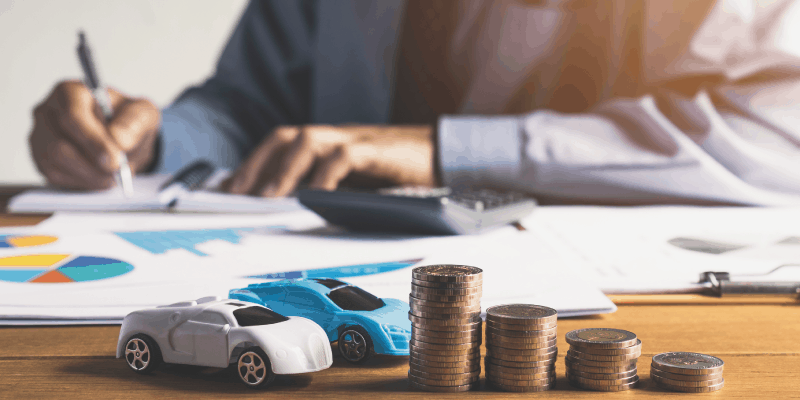
How Does Trading In A Vehicle Work?
Dreaming of that new car smell? We’ve all been there, though as much as we may want one, sometimes a brand new vehicle isn’t within our price range. That’s where a trade-in comes in handy.
So what is a trade-in vehicle? The trade-in process is simple: you bring in your used vehicle, a dealership evaluates what it’s worth, then they offer you a sum of money which you can put towards a newer vehicle. If you live nearby, you can trade in your vehicle in Winnipeg at Birchwood Credit.
In this blog, we’ll tell you all about the trade-in process including how to do it (even if your car is financed or leased) and how to maximize your trade-in. Before you know it, you’ll be all set and ready to upgrade your ride.
KEY TAKEAWAYS
- Trading in a car means you are using the value of your vehicle to reduce the cost of a new car purchase.
- Birchwood Credit has a simple process for trading in your vehicle in Winnipeg.
- If you’re currently paying off your vehicle, trading it in is still an option.
- Positive equity means your car is worth more than what you owe on the loan.
- Negative equity means you owe more on your car than what it’s worth.
HOW TRADING IN VEHICLES WORKS IN CANADA
When trading in a car at a dealership in Canada, you are simply using the value of your trade-in vehicle to reduce the total price of your new vehicle purchase. The trade-in car’s model, year, and condition will determine the amount discounted off of the new car purchase price. The dealership will then get your car ready for resale.
If you aren’t looking to make a new car purchase at the time of the trade-in, you can decide to receive a cash credit instead.
How To Trade In Your Vehicle in Winnipeg?
If you’re ready to trade in your vehicle in Winnipeg, we can help you get started.
Make an appointment
The first step in the trade-in process is making the appointment. Contact our team and choose the best location for you to visit. If you want an estimation of your vehicle value, you can use Birchwood’s Value Your Trade tool or the Canadian Black Book.
We evaluate your current vehicle
When you come in for your appointment, we’ll have a look at your vehicle to determine its trade-in value. Here are some of the common things we’ll look for:
- Vehicle make, model, year and popularity
- Trim packages, extra features, add-ons
- Kilometers driven
- Accident, maintenance and repair history
- Wear and tear on the interior, exterior and under the hood
- Competitive prices for similar models in the area
We give you an offer
Once we’ve evaluated your vehicle’s trade-in value, we’ll present you with an offer for your used vehicle. This offer is based on its value and any costs it’ll take to get it reconditioned to be sale ready.
If you’ve accepted the offer, you can use the earnings towards an upgraded vehicle in our inventory!
*For a limited time, we’re accepting all vehicle makes, models and years and if you trade in before September 30th, we’ll give you minimum $1500, guaranteed.

HOW TRADING IN A FINANCED VEHICLE WORKS
If you’re still paying off a car, you can still trade it in! But how does it work when trading in a car with a loan? The process is actually very similar: With a non-loan trade-in, the value of your car can be put toward a new car. When you’re trading in a financed vehicle, the value of your car becomes credit toward your loan.
There’s a chance this credit will cover the remainder of your loan but if it doesn’t, your loan will roll over (minus the amount you were given for your used vehicle). You’ll then have one singular loan for your upgraded vehicle.
Positive Equity Trades
Positive equity means your car is worth more than what you owe on the loan. This means there will be a remaining balance that will be applied to the car you’re purchasing, which will lower the overall amount you need to borrow for your new vehicle.
When the amount you owe on the car is less than the trade-in value, the process is pretty straightforward. For example, let’s say you still owe $5,000 on your car and the dealer offers you $6,000 for it as a trade-in. The dealer pays off the $5,000 loan for you, which then releases the lien. You would then transfer ownership of the car to the dealer and have $1,000 toward another vehicle.
Negative Equity Trades
On the other hand, it’s possible to owe more on your car than what it’s worth. Negativity equity means your loan value is higher than your car’s trade-in value—also sometimes known as an ‘upside down’ loan.
For example, let’s say you bought a car a year ago for $30,000 with zero money down, but you want to trade it in for a newer model. The car’s value might only be worth $20,000 now due to depreciation, so the remaining loan amount could end up being $25,000—which means you will still owe $5,000 after the loan is paid off.
Trading in a car with negative equity is often very simple for a dealership. Basically, the amount you’re ‘upside-down’ from your previous loan will just be tacked onto the loan for the new car you’re purchasing. Keep in mind that you will likely have higher monthly payments on your new car loan if you have negative equity.
TRADING IN A VEHICLE THAT’S FINANCED VS. LEASED
Yes, trading in a car that’s leased is possible! We’ll walk you through how it works so you can decide if it’s the best option for you.
When you lease a vehicle, you are essentially paying for the depreciation of the vehicle for the amount of time you’re driving it. You don’t own the vehicle and you either give it back or purchase the vehicle at the end of the lease term. If you’re trading in a car that is leased, you’ll have to determine if the vehicle has any equity. The vehicle equity at the end of the lease term is called residual value and it’s the amount someone could purchase the car for at the end of the lease term.
So how can you trade in a leased vehicle? Here are a few scenarios:
Your lease contract has ended and you want to trade the vehicle in for a new one. In this scenario, you’d have to find out the trade-in value of your vehicle and compare it to the residual value determined in your lease contract. If the trade-in value is higher, you will have some equity that can be put toward your new purchase (or lease).
You’re nearing the end of your lease and want to trade in the vehicle for a new one. If your lease isn’t quite up, the best-case scenario is the dealership pays off your old lease balance and buys the car from the lease company. If the dealership pays off the lease and takes the car for its lot, you could be given trade-in credit to put toward a newer vehicle. However, you run the risk that the cost of the lease contract is higher than the trade-in value, in which case you could end up owing more money on your new purchase.
If you’re trading in a car that’s leased, we recommend trading in when it’s complete or nearing the end, rather than earlier on in the lease contract where you may end up with high negative equity and no trade credit.
If you’re trading in a vehicle that’s fully paid off, you’re going to get the best bang for your buck. When your vehicle is appraised and given a value, you can use that credit as a down payment toward your upgraded vehicle. That down payment will mean fewer car payments in the long run, saving you money over time.
TRADING IN A VEHICLE THAT’S FINANCED VS. LEASED
Yes, trading in a car that’s leased is possible! We’ll walk you through how it works so you can decide if it’s the best option for you.
When you lease a vehicle, you are essentially paying for the depreciation of the vehicle for the amount of time you’re driving it. You don’t own the vehicle and you either give it back or purchase the vehicle at the end of the lease term. If you’re trading in a car that is leased, you’ll have to determine if the vehicle has any equity. The vehicle equity at the end of the lease term is called residual value and it’s the amount someone could purchase the car for at the end of the lease term.
So how can you trade in a leased vehicle? Here are a few scenarios:
Your lease contract has ended and you want to trade the vehicle in for a new one.
In this scenario, you’d have to find out the trade-in value of your vehicle and compare it to the residual value determined in your lease contract. If the trade-in value is higher, you would have some equity that can be put towards your new purchase (or lease).
You’re nearing the end of your lease and want to trade the vehicle for a new one.
If your lease isn’t quite up, the best case scenario is the dealership pays off your old lease balance and buys the car from the lease company. If the dealership pays off the lease and takes the car for their lot, you could be given trade-in credit to put towards a newer vehicle. However, you run the risk that the cost of the lease contract is higher than the trade-in value, in which case you could end up owing more money on your new purchase.
If you want to trade in a lease, we recommend trading in when it’s complete or nearing the end, rather than earlier on in the lease contract where you may end up with high negative equity and no trade credit.
3. How to trade in a vehicle that has been paid off.
If you’re trading in a vehicle that’s fully paid off, you’re going to get the best bang for your buck. When your vehicle is appraised and given a value, you can use that credit as a down payment towards your upgraded vehicle. That down payment will mean less car payments in the long run, saving you money over time.

HOW SOON CAN YOU TRADE IN A FINANCED CAR?
The short answer is… anytime! That is—if you can find a dealership that is willing to make you a trade-in offer. Just keep in mind that it’s best to wait until you’ve paid enough on your car loan to have positive equity so that you’ll make some extra cash for your next vehicle.
WHEN IT’S A GOOD IDEA TO TRADE IN A FINANCED VEHICLE
Timing your trade-in can sometimes be tricky. This is because the longer you wait, the more your car will depreciate. Also, if you’re still making payments on your car loan, you might end up owing more than your car is worth (negative equity). There is unfortunately not a black and white rule—but the best time to do a trade-in is when you have positive equity.
HOW VALUE OF A CAR IS DETERMINED
Dealerships will consider the following factors when determining the trade-in value of your car:
- Year, make, model, and trim
- Added features and extras
- Number of kilometres
- Condition of interior, exterior, engine, powertrain, tires, and brakes
- The current local supply and average selling price of similar vehicles
The car dealership will do an overall inspection of your proposed trade-in vehicle. If it decides to accept a trade-in that requires work, the damage will lower its trade-in value. This is why it’s important to do all simple repairs to your vehicle before you bring it in for a trade.
WHAT YOU NEED TO TRADE IN A CAR
Whether you have positive or negative equity, completing a trade-in has the same requirements. It’s a legal transaction and you’ll need the following:
Vehicle Registration: You’ll need this to fill out a transfer of ownership to the dealership.
Piece of ID: You’ll need to prove that you’re the person on the registration and where you reside. A driver’s licence is usually enough.
Proof of Income: For securing a car loan, you’ll need to bring a recent pay stub with year-to-date earnings.
MAXIMIZING THE TRADE-IN VALUE OF YOUR CAR
Like everything else in the car-buying process, trade-in value is up for negotiation. The better shape your car is in, the better price the dealer will offer.
Here are some tips for maximizing your trade-in.
- Clean the interior and exterior. This simple step is often overlooked. If you really want your car to shine (literally), give it a nice wash through and through before visiting the dealer.
- Stay up-to-date with maintenance. Make sure you service your vehicle regularly and keep the records. You’ll likely get more value for your trade if your car has been well-maintained over the years.
- Make any necessary repairs. If your vehicle has a noticeable mechanical or cosmetic issue, get it taken care of now as it could result in a higher trade-in value later.
- Bring important documents. Grab a folder and bring all your vehicle documents including registration, service records and routine maintenance. This will show the dealer you’ve tended to the vehicle and will hopefully get you a higher trade-in value.
- Don’t forget the accessories and extras. If your vehicle came with two keys, a movie system and remotes or a special sound system, make sure all of these added elements are brought to the dealership.
- Know your vehicle’s estimated value. If you head to the lot with a general idea of your car’s value, you’ll be better equipped to negotiate. Do some research ahead of time to ensure you come prepared.
WHAT DEALERSHIPS WILL DO WITH TRADE-INS
Once the trade-in agreement is finalized, the dealership will take possession of your vehicle and handle paying out your old car loan balance. Dealerships make a profit through re-selling used cars and the goal is for them to always have a full inventory. The dealer will refurbish the car to sell by doing mechanical repairs, getting safety certifications, and doing interior and exterior detailing.
Sometimes, your vehicle is beyond the point of being suitable for resale or didn’t pass the resale requirements—maybe your car has too many kilometres, is over six years old, the dealership already has multiple models of the same car on the lot, or the make of the car is not what the dealership prefers to carry. In this case, the dealer will do one of these two things:
Wholesale the Vehicle: If your vehicle doesn’t pass the dealer’s resale requirements, it may decide to wholesale the vehicle to an auto broker. This means the wholesale dealer buys used vehicles and attempts to resell them at a profit at other auctions.
Auction Off the Vehicle: Dealerships often send cars to auction that don’t fit their needs. Some examples include modified vehicles, quirky colours, or vehicles that are in rough shape. It’s sometimes risky for dealerships to auction off cars, so they will always consider their potential losses before deciding to do so. This means trade appraisals might come in at a lower number because they need to account for that risk.
SECURING YOUR NEXT CAR LOAN
If a trade-in is in the cards for you, you’ve now got all the tools to make an informed decision that you’ll feel confident about. If you’re thinking about trading in your vehicle for a used one, here are 11 things to check before buying a used car. Our team would be happy to find a vehicle in our inventory that’s right for you.



